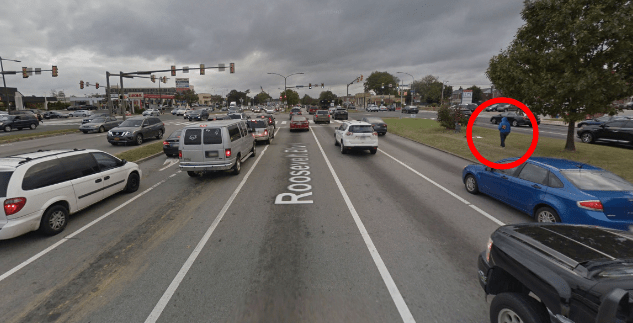Last week, an unlicensed driver struck and killed a young woman as she crossed Roosevelt Boulevard in Philadelphia -- the city's most dangerous street. The victim, whose name has not been released, was knocked out of her shoes by the force of the collision, according to the local ABC affiliate.
Roosevelt is a death trap. At 12 lanes wide, it's basically an at-grade highway through densely populated city neighborhoods. Every year, there are about 700 crashes and 10 traffic fatalities on this single street. At Roosevelt and Large, the site of the fatal crash last week, two sisters were killed in a collision just a year ago.
A 2001 review by State Farm Insurance found that two of the three most dangerous intersections in the United States are on Roosevelt Boulevard.
You can see one of those intersections -- Grant and Roosevelt -- in the Google Street View at the top of this post. It has all the hallmarks of a high-risk city street, including the presence of destinations that give people lots of reasons to walk. The intersection has a WalkScore of "79," meaning "most errands can be accomplished on foot."
Roosevelt runs through one of the nation's biggest cities, but six miles of the street don't even have sidewalks. Instead, every design cue drivers encounter urges them to speed. The speed limit is 45 mph, but it's ignored.
"It’s the worst," says Randy LoBasso, communications manager at the Bike Coalition of Greater Philadelphia. "You can’t go under 60 and feel like people aren’t on your bumper." LoBasso said police officers are afraid to pull anyone over on Roosevelt because there's no shoulder.
In the last five years, Roosevelt has been the site of 13 percent of all traffic deaths in Philadelphia. It's exactly the kind of arterial street that needs to be transformed if American cities are going to achieve lasting improvements in traffic safety.
The danger of Roosevelt Boulevard is the result of many years of haphazard planning, and fixing it won't be easy. As Mark Dent at BillyPenn explains, Roosevelt started out as a rural road. Then as the surrounding are became urbanized, the city added lanes.
A few years ago, the state set aside $8 million for measures like red light cameras and countdown timers at crosswalks. The fatality rate fell slightly but remains staggeringly high.
A separate $2.5 million federal grant is funding a study of long-term changes, with a focus on improving transit along the whole length of Roosevelt. But those improvements are expected to take many years.
Philadelphia can't wait that long, said LoBasso.

In the short term, the Bike Coalition is calling on the state legislature to allow speed cameras on Roosevelt. Pennsylvania state law doesn't allow speed cameras, or the use of speed-detecting radar by police. The legislature is dominated by Republicans and many have a libertarian bent that holds automated enforcement in suspicion.
But the Bike Coalition has an ally in Philadelphia Republican John Taylor, who lives near Roosevelt.
Advocates are trying to pass a state law that would allow a speed camera pilot on Roosevelt only. Among those advocating for the changes is LaTanya Bird. A speeding driver killed Bird's niece, Samara Banks, and three of Banks' four children as they were walking across Roosevelt in 2013. The driver was reportedly drag racing.
The bill was passed out of a committee, but has not gotten a vote in the full Pennsylvania House.
"It seems like a no brainer," said LoBasso. "Pedestrians are regularly killed on the street. Drivers are regularly killed on the street."
"It’s been really tough to get the bill done."
Now advocates are making a big push before the end of this legislative session, after which Taylor is planning to retire. A protest on Monday at Large and Roosevelt, where the young woman was killed last week, will demand action to prevent future loss of life.






